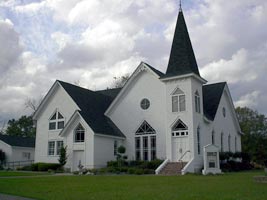Founded on the banks of the Chickasawhay River, Shubuta has an interesting past dating back to early Indian settlements. Derived from a Choctaw Indian word (Shoboti) the name means “smokey” and was given by the Indians to a nearby creek that is an arm of the Chickasawhay River that still has smokey waters. The town of Shubuta was established in 1853 when the Mobile & Ohio Railroad was built. The railroad became the lifeblood of the community, as trade and opportunity abounded from abundant farming and timber resources. Until the late 1800’s, Shubuta was commonly known as the largest town between Meridian and Mobile. Shubuta’s economic climate has grown from basically rural farms to larger timber and lumber operations and currently includes extensive oil and gas activity.
Shubuta Baptist Church

Circa 1848 • Victorian Carpenter Gothic • Eucutta Street at Highway 145.
This church displays a two-story tower with bell-cast pyramidal roof crowned by a finial and trimmed with brackets, a gable ornament, and oculus in each of the gables of the 1894 building.
Shubuta United Methodist Church

Circa 1891• Late Victorian Carpenter Gothic • High Street.
Twin-towered church with windows imported from Belgium.
Shutbuta Gazebo/Artesian Well
 Located at intersection of Station Street and Eucutta Street.
Located at intersection of Station Street and Eucutta Street.
At one time in Shubuta’s history, there were approximately fifty artesian wells, giving the trade hub a wholesome, healthful water supply. One of the most prominent wells was the one located in the center of Eucutta Street. Situated in front of the Hudson Drug Store, surrounded by cool shade trees and hitching posts, the well was covered by an attractive lattice house, later called a gazebo. The well provided an abundant supply of soft red water, rich in sodium bicarbonate. With its medicinal taste and deep tea color, the Indians refused to drink it and gave it an Indian name meaning poison. Later, young town blades would bottle this red water in whiskey bottles and sell it to unsuspecting passengers traveling through on local trains.
In 1922-23, Eucutta Street was paved, and the well had to be moved. At that time, the red water was piped from the original well to its present location. Not until the 1980’s did this well fail, and the new one was drilled.
The gazebo was moved to the city park at the time the road was paved. It was again moved with the new legs, new roof and new latticework, to the present location in order to provide cover for the town well and its patrons and to welcome newcomers.
Hand House
Circa 1850-1855 • Greek Revival • North Street and railroad tracks.
One of Shubuta’s remaining antebellum homes. It faces the M&O railroad tracks, upon which the first train arrived in 1855.
Price-Patton-Pettis House
Circa 1850,1890 • Greek Revival/Queen Anne Cottage • Corner of North and 2nd Street.
This is one of Shubuta’s only antebellum homes, and at one time was the home of Jenny McPhail Price and her sister, who came from South Carolina on a wagon train. Before the turn of the century, this was the home of W.H. Patton, a prominent citizen and businessman of Shubuta. He was an alderman and mayor of the town, a deacon of the Baptist church, and a member of the state executive committee of the Prohibition Party.
Shubuta Cemetery
 Beautiful old cemetery overlooking the banks of the Chickasawhay River. One of the last landmarks of Shubuta with beautiful moss-covered cedar trees and graves dating back to 1859. Contains monument to Confederate soldiers although no Confederate graves exist.Beautiful old cemetery overlooking the banks of the Chickasawhay River. One of the last landmarks of Shubuta with beautiful moss-covered cedar trees and graves dating back to 1859. Contains monument to Confederate soldiers although no Confederate graves exist.
Beautiful old cemetery overlooking the banks of the Chickasawhay River. One of the last landmarks of Shubuta with beautiful moss-covered cedar trees and graves dating back to 1859. Contains monument to Confederate soldiers although no Confederate graves exist.Beautiful old cemetery overlooking the banks of the Chickasawhay River. One of the last landmarks of Shubuta with beautiful moss-covered cedar trees and graves dating back to 1859. Contains monument to Confederate soldiers although no Confederate graves exist.
Shubuta Bridge
Circa 1909.
Austin Brothers Bridge Contractors of Atlanta, GA, built the Shubuta Bridge. An eighteen by sixteen foot bridge spanning the Chickasawhay River consists of one camelback truss span that was commonly used in the early twentieth century. This bridge is significant in that it embodies “the distinctive characteristics of a type, period, and method of construction.”
